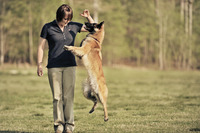This class will build your heeling skills from the ground up. From weight shift to head position, we will shape each component skill necessary for powerful and precise heeling. Each skill is taught separately, out of context (as what some might consider a “trick”), so that we can maximize motivation and minimize pressure. If it's all just tricks, it's all fun, right? Right!
We will be using a combination of shaping and targeting to build the behaviors necessary for the skills, and minimize the use of lures or prompting. A big part of our goal is to build these skills clean from the very beginning, and have good habits established on the human side and nothing to fade (or get too dependent on) on the dog's side.
You will be happiest in this class if you are comfortable with shaping behavior and have good click/treat mechanics. You'll get the most out of the class if your dog also has experience with chin, nose, and paw targeting, and front paw, back paw, and whole body platforms. However, because we are building these behaviors from scratch, you don’t need to have any heeling-specific experience on board (either you or the dog).
If you have already taught your dog to heel with a different method, you may find that these exercises are not exactly review, but act synergistically to strengthen your dogs understanding of both stationary and moving heel position. However, because every instructor's progression is a little different (even though we are all working toward the same end goal of beautiful heeling), you should expect to work through all of the exercises as described, particularly if you intend to continue on into Part 2 and 3 of this series. The exercises in Part 2 and 3 will build directly off the exercises in this class, layering in complexity and putting the pieces together to form the finished product.
**This class will have an amazing Teaching Assistant to answer any questions from participants (any level) in the associated Facebook group for this class. She is seriously the best TA in the world.
 Instructor: Hannah Branigan
Instructor: Hannah Branigan